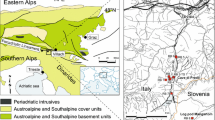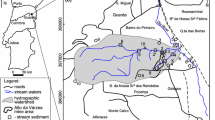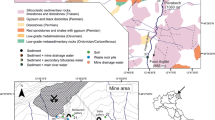Abstract
Acid mine drainages (AMD) have adversely affected the southern Apuan Alps (northern Tuscany, Italy). The study particularly focuses on the Baccatoio stream, which receives AMD from the abandoned Pollone and M. Arsiccio mines. The mine waters have an average pH of 2.2 and contain potentially toxic elements (PTE) at concentrations that exceed the Italian regulatory threshold for Al, Fe, Mn, Cu, Zn, As, Ni, Co, Cd, Sb, Pb, and Tl. The AMD flow directly into the stream, severely contaminating it. Downstream of the mined areas, the pH increases and most PTE (especially Fe, Al, As, and Pb) are readily scavenged from the stream waters by precipitation and/or adsorption. However, Tl, which peak at 1000 µg/L in the AMD, behaves almost conservatively along the stream flow path, undergoing only dilution, and remains at or above the concentration of concern of 4 µg/L almost to the coastline, before sharply decreasing to 0.5 µg/L where seawater is encountered. Since the stream water was locally used for irrigation, these observations may have important environmental and public health consequences in such a densely populated area.
抽象
酸性矿山废水严重影响意大利托斯卡纳北部Apuan Alps地区。主要研究了接受废弃Pollone矿和M. Arsiccio矿酸性矿山废水汇入的Baccatoio河流。矿山废水平均pH值2.2并含有超过意大利规定浓度标准的潜在有害元素(PTE),包括Al、Fe、Mn、Cu、Zn、As、Ni、Co、Cd、Sb、Pb和Tl。酸性矿山废水直接排入且严重污染河流。沉淀和吸附作用使矿区下游河水pH值升高,多数PTE元素(尤其Fe、Al、 As和Pb)减少。但是,铊(在酸性废水中最大浓度1000μm/L)沿河流浓度稳定,以稀释作用为主;至海岸线附近时,铊浓度一直维持于4μm/L上下;最终汇入海水时,铊浓度陡然降至0.5 µg/L。河水主要用于农田灌溉,研究对人口稠密区具有重要环境和公共健康意义。
Zusammenfassung
Saure Grubenwässer wirken sich auf die südlichen Apuaner Alpen (Nordtoskana, Italien) nachteilig aus. Die Studie konzentriert sich insbesondere auf den Baccatoiofluss, der mit sauren Grubenwässern von den Altbergbauen in Pollone und am Monte Arsiccio beaufschlagt wird. Die Grubenwässer haben einen pH-Wert von 2,2 und enthalten potentiell toxische Elemente in Konzentrationen die die italienischen gesetzlichen Grenzwerte für Al, Fe, Mn, Cu, Zn, As, Ni, Co, Cd, Sb, Pb and Tl überschreiten. Die sauren Grubenwässer fließen direkt in den Fluss und belasten ihn schwerwiegend. Flussabwärts der Bergbaugebiete steigt der pH-Wert und die meisten potentiell toxischen Elemente (insbesondere Fe, Al, As und Pb) werden einfach durch Ausfällung und/oder Adsorbtion aus dem Wasserstrom ausgeschieden. Tl mit einer Höchstkonzentration von 1000 µg/l im sauren Grubenwasser verbleibt jedoch entlang des Fließpfades nahezu unbeeinflusst und unterliegt lediglich der Verdünnung. Die maßgebliche Grenzkonzentration bleibt beinahe bis zur Küste bei oder über 4 µg/l bevor sie schlagartig beim Zusammentreffen mit Meerwasser auf 0,5 µg/l abnimmt. Seit das Flusswasser lokal zu Bewässerungszwecken verwendet wird, können diese Beobachtungen in einem derart dicht besiedelten Gebiet schwerwiegende Auswirkungen auf die Umwelt und die öffentliche Gesundheit haben.
Resumen
Los drenajes ácidos de mina (AMD) han afectado negativamente los alpes Apuan (norte de la Toscana, Italia). El estudio se focaliza sobre el arroyo Baccatoio que recibe AMD de las minas abandonadas Pollone y M. Arsiccio. Las aguas de mina tienen un pH promedio de 2,2 y contienen elementos potencialmente tóxicos (PTE) a concentraciones que exceden el marco regulatorio italiano para Al, Fe, Mn, Cu, Zn, As, Ni, Co, Cd, Sb, Pb y Tl. El flujo de AMD directamente dentro del curso de agua, lo afecta severamente. Corriente abajo de las áreas mineras, el pH crece y la mayoría de los PTE (especialmente Fe, Al, As y Pb) se eliminan fácilmente por precipitación y/o adsorción. No obstante, Tl, con un máximo de 1000 μg/L en el AMD, prácticamente se conserva a lo largo del paso del flujo del curso, sufre sólo dilución y permanece en o por encima de la concentración de 4 μg/L casi hasta la costa, antes de decrecer rápidamente a 0,5 μg/L cuando se encuentra con el agua de mar. Como este curso de agua fue usado localmente para riego, estas observaciones pueden tener importancia ambiental y consecuencias para la salud pública en un área tan densamente poblada.
Similar content being viewed by others
References
Biagioni C, D’Orazio M, Vezzoni S, Dini A, Orlandi P (2013) Mobilization of Tl–Hg–As–Sb–(Ag,Cu)–Pb sulfosalt melts during low-grade metamorphism in the Alpi Apuane (Tuscany, Italy). Geology 41:747–750
Biagioni C, Bonaccorsi E, Moëlo Y, Orlandi P (2014a) Mercury-arsenic sulfosalts from the Apuan Alps (Tuscany, Italy). I. Routhierite, (Cu0.8Ag0.2)Hg2Tl(As1.4Sb0.6)Σ = 2S6, from Monte Arsiccio mine: occurrence and crystal structure. Eur J Miner 26:163–170
Biagioni C, Bonaccorsi E, Moëlo Y, Orlandi P, Bindi L, D’Orazio M, Vezzoni S (2014b) Mercury-arsenic sulfosalts from the Apuan Alps (Tuscany, Italy). II. Arsiccioite, AgHg2TlAs2S6, a new mineral from the Monte Arsiccio mine: occurrence, crystal structure and crystal chemistry of the routhierite isotypic series. Mineral Mag 78:101–117
Bidoglio G, Gibson PN, O’Gorman M, Roberts KJ (1993) X-ray absorption spectroscopy investigation of surface redox transformations of thallium and chromium on colloidal mineral oxides. Geochim Cosmochim Acta 57(10):2389–2394
Carmignani L, Dessau G, Duchi G (1972) I giacimenti minerari delle Alpi Apuane e le loro correlazioni con l’evoluzione del gruppo montuoso. Mem Soc Geol Ital 11:417–431 (in Italian)
Carmignani L, Dessau G, Duchi G (1976) I giacimenti a barite, pirite ed ossidi di ferro delle Alpi Apuane. Studio minerogenico e strutturale. Boll Soc Geol Ital 95:1009–1061 (in Italian)
Casiot C, Egal M, Bruneel O, Verma N, Parmentier M, Elbaz-Poulichet F (2011) Predominance of aqueous Tl(I) species in the river system downstream from the abandoned Carnoules Mine (southern France). Environ Sci Technol 45(6):2056–2064
Chen A, Lin C, Lu W, Wu Y, Ma Y, Li J, Zhu L (2007) Well water contaminated by acidic mine water from the Dabaoshan Mine, South China: chemistry and toxicity. Chemosphere 70:248–255
Cheng H, Hu Y, Luo J, Xu B, Zhao J (2009) Geochemical processes controlling fate and transport of arsenic in acid mine drainage (AMD) and natural systems. J Hazard Mater 165:13–26
Cidu R (2011) Mobility of aqueous contaminants at abandoned mining sites: insights from case studies in Sardinia with implications for remediation. Environ Earth Sci 64(2):503–512
Cidu R, Frau F (2009) Distribution of trace elements in filtered and non filtered aqueous fractions: Insights from rivers and streams of Sardinia (Italy). Appl Geochem 24:611–623
Costagliola P, Benvenuti M, Lattanzi P, Tanelli G (1998) Metamorphogenic barite–pyrite (Pb–Zn–Ag) veins at Pollone, Apuane Alps, Tuscany: vein geometry, geothermobarometry, fluid inclusions and geochemistry. Miner Petrol 62:29–60
D’Orazio M, Biagioni C, Vezzoni S, Dini A (2015) Inside the mine: interactions between hydrosphere, atmosphere, biosphere and the thallium-rich pyrite ores from southern Apuan Alps. Rend Online Soc Geol Ital 35(2):298–298
D’Orazio M, Biagioni C, Dini A, Vezzoni S (2017) Thallium-rich pyrite ores from the Apuan Alps, Tuscany, Italy: constraints for their origin and environmental concerns. Miner Depos 52:687–707
Edraki M, Golding SD, Baublys KA, Lawrence MG (2005) Hydrochemistry, mineralogy and sulfur isotope geochemistry of acid mine drainage at the Mt. Morgan mine environment, Queensland, Australia. Appl Geochem 20(4):789–805
Emsbo P, Hofstra AH, Lauha EA, Griffin GL, Hutchinson RW (2003) Origin of high-grade gold ore, source of ore fluid components, and genesis of the Meikle and neighboring Carlin-type deposits, northern Carlin Trend, Nevada. Econ Geol 98:1069–1105
Fellin MG, Reiners PW, Brandon MT, Wüthrich E, Balestrieri ML, Molli G (2007) Thermochronologic evidence for exhumational history of the Alpi Apuane metamorphic core complex, northern Apennines, Italy. Tectonics 26:TC6015
Fergusson JE (1990) Heavy elements: chemistry, environmental impact and health effects. Pergamon Press, Oxford
Flegal AR, Patterson CC (1985) Thallium concentration in sea water. Marine Chem 15(4):327–331
Giannecchini R, D’Amato Avanzi G (2012) Historical research as a tool in estimating hydrogeological hazard in a typical small alpine-like area: the example of the Versilia River basin (Apuan Alps, Italy). Phys Chem Earth 49:32–43
Jacobson AR, McBride MB, Baveye P, Steenhuis TS (2005) Environmental factors determining the trace-level sorption of silver and thallium to soils. Sci Total Environ 345(1-3):191–205
Laforte L, Tessier A, Gobeil C, Carignan R (2005) Thallium diagenesis in lacustrine sediments. Geochim Cosmochim Acta 69(22):5295–5306
Large RR, Danyushevsky L, Hollit C, Maslennikov V, Meffre S, Gilbert S, Bull S, Scott R, Emsbo P, Thomas H, Singh B, Foster J (2009) Gold and trace element zonation in pyrite using a laser imaging technique: implications for the timing of gold in orogenic and Carlin-style sediment-hosted deposits. Econ Geol 104:635–668
Lattanzi P, Benvenuti M, Costagliola P, Tanelli G (1994) An overview on recent research on the metallogeny of Tuscany, with special reference to the Apuane Alps. Mem Soc Geol Ital 48:613–625
Law S, Turner A (2011) Thallium in the hydrosphere of south west England. Environ Poll 159(12):3484–3489
Lin TS, Nriagu J (1998) Revised hydrolysis constants for thallium(I) and thallium(III) and the environmental implications. J Air Waste Manag Assoc 48(2):151–156
Molli G, Giorgetti G, Meccheri M (2002) Tectono-metamorphic evolution of the Alpi Apuane metamorphic complex: new data and constraints for geodynamic models. Boll Soc Geol Ital 121(2):789–800
Moore JN, Luoma SN (1990) Hazardous wastes from large-scale metal extraction. A case study. Environ Sci Technol 24(9):1278–1285
Nordstrom DK (2011) Hydrogeochemical processes governing the origin, transport and fate of major and trace elements from mine wastes and mineralized rock to surface waters. Appl Geochem 26:1777–1791
Nordstrom DK, Blowes DW, Ptacek CJ (2015) Hydrogeochemistry and microbiology of mine drainage: An update. Appl Geochem 57:3–16
Peter AL, Viraraghavan T (2005) Thallium: a review of public health and environmental concerns. Environ Int 31(4):493–501
Petrini R, D’Orazio M, Giannecchini R, Bramanti E (2015) Thallium ecosystem diseases in dismissed mine sites as a threat for public health: the Valdicastello-Pietrasanta (Italy) case history. Rend Online Soc Geol Ital 35(2):312–312
Petrini R, Cidu R, Slejko F (2016) Thallium contamination in the Raibl mine site stream drainage system (eastern Alps, Italy). Mine Water Environ 35:55–63
Piccini L, Pranzini G, Tedici L, Forti P (1999) Le risorse idriche degli acquiferi carbonatici del comprensorio Apuo-Versiliese. Quad Geol Appl 6:61–78 (in Italian)
Plumlee GS, Smith KS, Montour MR, Ficklin WH, Mosier EL (1999) Geologic controls on the composition of natural waters and mine waters draining diverse mineral-deposit types. In: Filipek LH, Plumlee GS (eds) The environmental geochemistry of mineral deposits. Part B: case studies and research topics. Rev Econ Geol 6(B):373–432
Rehkämper M, Nielsen SG (2004) The mass balance of dissolved thallium in the oceans. Mar Chem 85(3-4):125–139
Scott RJ, Meffre S, Woodhead J, Gilbert SE, Berry RF, Emsbo P (2009) Development of framboidal pyrite during diagenesis, low-grade regional metamorphism, and hydrothermal alteration. Econ Geol 104:1143–1168
Turner A, Cabon A, Glegg GA, Fisher AS (2010) Sediment–water interactions of thallium under simulated estuarine conditions. Geochim Cosmochim Acta 74:6779–6787
Vittori Antisari L, Ferronato C, Vianello G (2016) Potentially toxic elements transfer from sulphides contaminated soils to cultivated plants: the case of mining district Pietrasanta-Valdicastello (province of Lucca, Italy). In: Unpubl scientific communication presented to the workshop (second session): PTEs contamination in water–soil–plant systems: remediation processes. 8-9 June 2016. Palazzo Sersanti, Imola
Wedepohl KH (1995) The composition of continental crust. Geochim Cosmochim Acta 59(7):1217–1232
Xiao T, Guha J, Boyle D, Liu CQ, Zheng B, Wilson GC, Rouleau A, Chen J (2004) Naturally occurring thallium: a hidden geoenvironmental health hazard? Environ Int 30:501–507
Xiao T, Yang F, Li S, Zheng B, Ning Z (2012) Thallium pollution in China: a geo-environmental perspective. Sci Total Environ 421–422:51–58
Acknowledgements
This research was financially supported by Regione Toscana. The authors thank the Pietrasanta Municipality for providing access to the sampling areas and to Emilia Bramanti, Massimo Onor, Beatrice Campanella (CNR-ICCOM), and Marco Doveri (CNR-IGG) for their assistance and fruitful discussions.
Author information
Authors and Affiliations
Corresponding author
Rights and permissions
About this article
Cite this article
Perotti, M., Petrini, R., D’Orazio, M. et al. Thallium and Other Potentially Toxic Elements in the Baccatoio Stream Catchment (Northern Tuscany, Italy) Receiving Drainages from Abandoned Mines. Mine Water Environ 37, 431–441 (2018). https://doi.org/10.1007/s10230-017-0485-x
Received:
Accepted:
Published:
Issue Date:
DOI: https://doi.org/10.1007/s10230-017-0485-x










